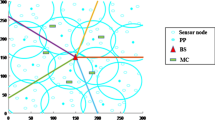Abstract
In Wireless Sensor Networks, the available energy of the prevailing sensor nodes is limited and is difficult to replenish. It is very critical to supervise the available energy. In Mission Critical Surveillance application, due to node’s battery depletion, coverage hole may be created. Hole at Critical Point (CP) leads to the degradation of performance of overall network. It is merely impossible, to redeploy sensor nodes or to recharge the battery while monitoring. The proposed Energy Balanced-Dynamic Deployment Optimization approach, positions the self deployable mobile sensors towards CP according to its available Energy Density. This balances the Energy Density of the network thereby increasing the Reliable Lifetime. The simulation results show the effectiveness of the approach in terms of the balanced Energy Density around CPs with less mobility.









Similar content being viewed by others
References
Akyildiz, I. F., Su, W., Sankrasubramaniam, Y., & Cayirci, E. (2002). A survey on sensor networks. IEEE Communications Magazine, 40(8), 102–114.
Sanoob, A. H., Roselin, J., & Latha, P. (2016). Smartphone enabled intelligent surveillance system. IEEE Sensors Journal, 99, 1361–1367.
Mostafaei, H., & Shojafar, M. (2015). A new meta-heuristic algorithm for maximizing lifetime of wireless sensor networks. Wireless Personal Communication, 82(2), 723–742.
Dietrich, I., & Dressler, F. (2009). On the lifetime of wireless sensor networks. ACM Transactions on Sensor Networks, 5(1), 1–39.
Sibley, G. T., Rahimi, M. H., & Sukhatme, G. S. (2008). Robomote: A tiny mobile robot platform for large-scale sensor networks. In IEEE international conference on robotics and automation (pp. 1143–1148).
Aznoli, F., & Navimipour, N. J. (2016). Deployment strategies in the wireless sensor networks: Systematic literature review, classification, and current trends. Wireless Personal Communications, 1–28.
Kennedy, J., & Eberhart, R. (1995). Particle swarm optimization. In Proceedings of the IEEE international conference on neural networks, Perth, Australia (pp. 1942–1945).
Yang, S., Li, M., & Wu, J. (2007). Scan-based movement-assisted sensor deployment methods in wireless sensor networks. IEEE Transaction Parallel and Distributed Systems, 18(8), 1108–1121.
Chellappan, S., Bai, X., Ma, B., Xuan, D., & Xu, C. (2007). Mobility limited flip-based sensor networks deployment. IEEE Transaction Parallel and Distributed Systems, 18(2), 199–211.
Howard, A., Mataric, M. J., & Sukhatme, G. S. (2002). Mobile sensor network deployment using potential fields: A distributed, scalable solution to the area coverage problem. In Proceedings sixth international symposium on distributed autonomous robotics systems.
Ko, A. H. R., Jousselme, A.-L., & Maupin, P. (2011). A coverage dominance approach for sensor deployment optimization. In 14th international conference on information fusion, Chicago, Illinois, USA.
Jun, L., & Gui, W. (2012). Node deployment strategy optimization for wireless sensor network with mobile base station. Berlin: Springer.
Zhang, L., Li, D., Zhu, H., & Cui, L. (2012). OPEN: An optimization scheme of N-node coverage in wireless sensor networks. Institution of Engineering and Technology.
Ozturk, C., Karaboga, D., & Gorkemli, B. (2012). Artificial bee colony algorithm for dynamic deployment of wireless sensor networks. Turkish Journal of Electrical Engineering & Computer Sciences, 20, 255–262.
Wang, X., Ma, J.-J., Wang, S., & Bi, D.-W. (2007). Prediction based dynamic energy management in wireless sensor networks. Sensors, 7(3), 251–266.
Kulkarni, R. V., & Venayagamoorthy, G. K. (2010). Bio-inspired Algorithms for Autonomous Deployment and Localization of Sensor Nodes. IEEE Transactions on Systems, Man, And Cybernetics, 40(6), 663–675.
Salehizadeh, S. M. A., Dirafzoon, A., Menhaj, M. B., & Afshar, A. (2010). Coverage in wireless sensor networks based on individual particle optimization. In IEEE transaction on instrumentation and measurement.
Kumar, V., Khanna, P., & Bisht, S. (2012). Adaptive PSO based algorithm for optimal WSN deployment in 3D terrains. International Journal of Computer Applications.
Zhou, H., Liang, T., Xu, C., & Xie, J. (2012). Multi objective coverage control strategy for energy-efficient wireless sensor networks. International Journal of Distributed Sensor Networks.
Zou, Y., & Chakrabarty, K. (2003). Sensor deployment and target localization based on virtual forces. In Proceedings IEEE INFOCOM (pp. 1293–1303).
Shi, Y., & Krohling, R. A. (2002). Co-evolutionary particle swarm optimization to solve min–max problems. In Proceedings congress on evolutionary computation (pp. 1682–1687).
Wang, X., Wang, S., & Ma, J. (2007). An improved co-evolutionary particle swarm optimization for wireless sensor networks with dynamic deployment. Sensors, 7(3), 354–370.
Wang, X., & Wang, S. (2011). Hierarchical deployment optimization for wireless sensor networks. IEEE Transaction Mobile Computing, 10(7), 1028–1041.
Wang, L., Ji, H., & Gao, X. (2004). Clustering based on possibilistic entropy. In Proceedings of the seventh international conference on signal processing (pp. 1467–1470).
Author information
Authors and Affiliations
Corresponding author
Rights and permissions
About this article
Cite this article
Roselin, J., Latha, P. Prioritized Mobile Node Deployment to Enhance the Lifetime of Wireless Sensor Network. Wireless Pers Commun 96, 3693–3711 (2017). https://doi.org/10.1007/s11277-017-4062-1
Published:
Issue Date:
DOI: https://doi.org/10.1007/s11277-017-4062-1




